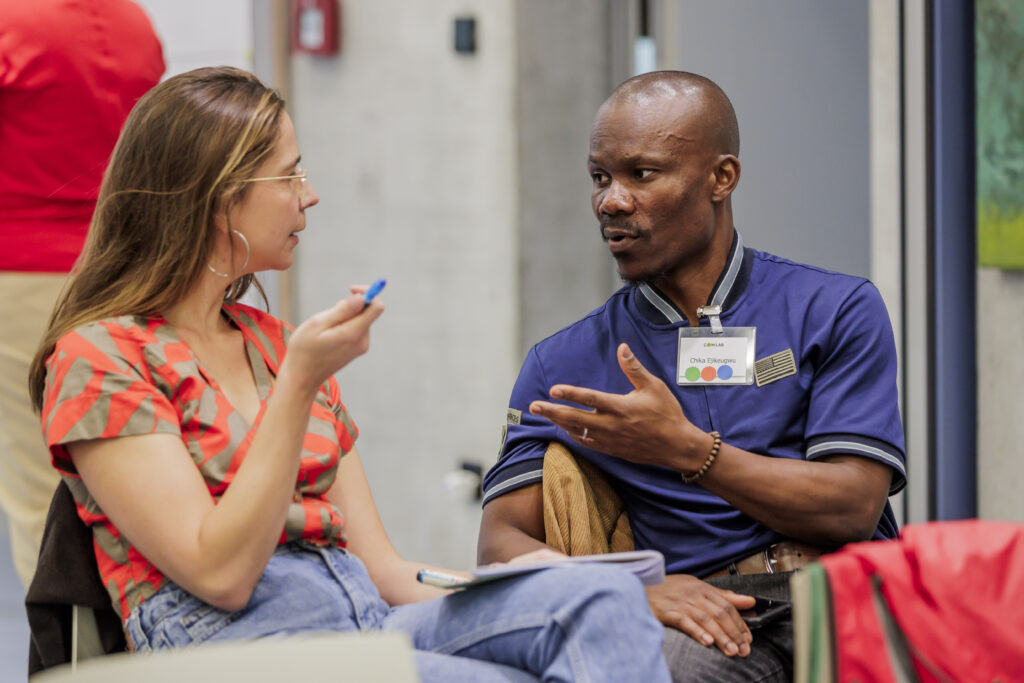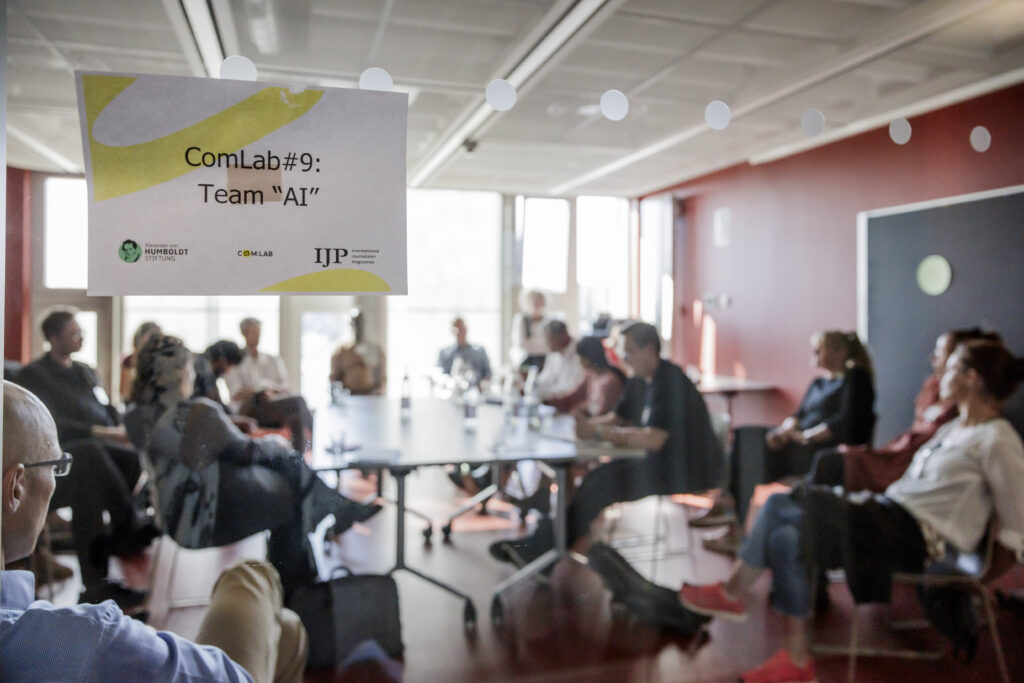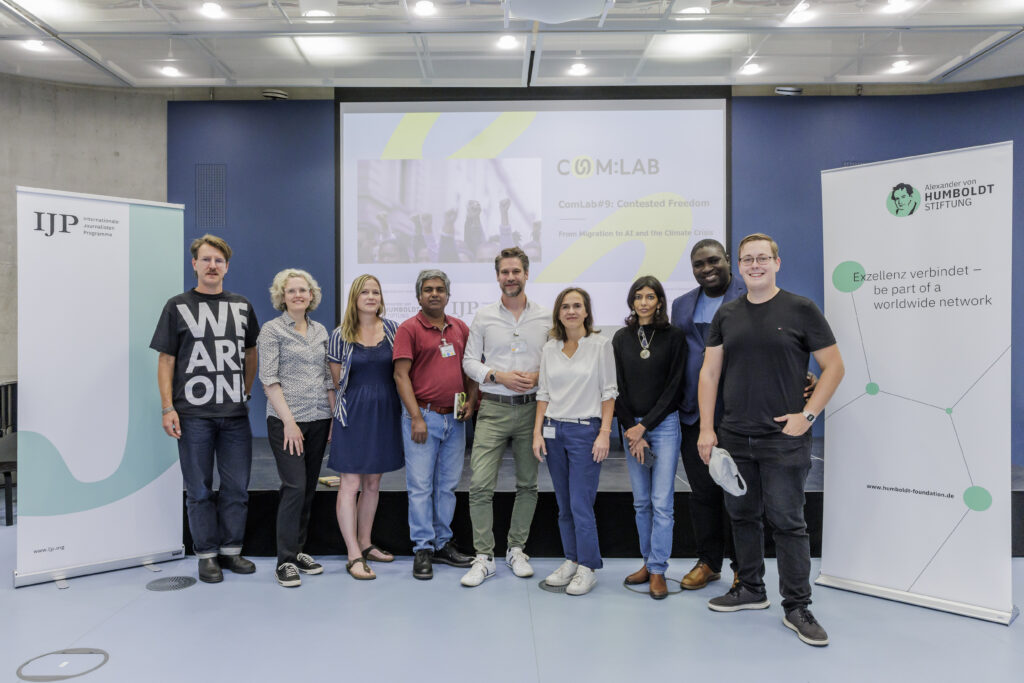ComLab #9 Bridging Science and Media for Impactful Global Storytelling

September 19 – 22, 2024 | live in Berlin
ComLab #9, a collaboration between the International Journalists’ Programmes (IJP) and the Alexander von Humboldt Foundation, brought journalists and scientists together in an inspiring exchange of ideas and perspectives. Over the course of four days, these dedicated professionals formed science-media tandems, uniting their expertise to address some of the most pressing global challenges—migration, climate change, and AI. Central to the event was a pitch competition, where participants presented innovative project ideas, all shaped by the guidance of experienced mentors.

What made ComLab#9 truly special was the deep, mutual learning experience. Journalists and scientists explored how to bridge the gap between complex research and accessible storytelling, tackling tough questions about misinformation, social media’s impact, and the ethical responsibilities of both fields. Through panel discussions, workshops, and group projects, they shared not just their knowledge but their passions—seeking to find new ways to communicate critical issues to the world.

Pitch Competition: Celebrating Creative Science Storytelling
At the heart of ComLab#9 was the exciting and highly anticipated pitch competition, where participants showcased their collaborative project ideas to an esteemed international jury of editors—Sahana Ghosh (Nature India), Jens Radü (Der Spiegel), and Heike Vowinkel (t-online). The jury was not only looking for strong ideas but for projects that stood out with their creativity, the originality of their topics, and the seamless blending of scientific expertise with captivating storytelling tailored to different audiences.
In the end, three teams truly captured the jury’s attention with their innovative and heartfelt approaches. Awards were presented to:
- Nigerian digital humanities researcher Onwu Inya and Slovakian journalist Tomáš Hrivňák for their story “Geni’s Adventure and the Knowledge tree: Understanding AI like a 6 year old”;
- Bangladeshi environmental scientist Mohammed Mofizur Rahman and Danish journalist Lise Josefsen Hermann for their story “Salt – the silent killer in the soil”;
- German political and economic scientist Daniel Mügge and German political analyst Sabine Muscat for their story “Wired: The Avengers for Europe’s Digital Freedom”.
The energy in the room reached new heights when the audience cast their vote, awarding French Antarctic researcher Mathieu Casado and Serbian climate journalist Luka Stokic for their story “Sneaky Science”. This moment of celebration underscored the collaborative magic that defined ComLab#9—a powerful union of diverse minds coming together to create meaningful, impactful stories.


ComLab#9 at Berlin Science Week | November 2, 2024
Science meets Storytelling: How Journalism and Research Tackle Global Challenges
As part of Berlin Science Week, this unique event brought together science and journalism to explore challenges in communicating pressing global issues such as migration, climate change, and artificial intelligence. The panel, moderated by Stephanie Siewert from the Alexander von Humboldt Foundation, featured two participants from ComLab #9—Adrianna Borowicz from Poland and Sanam Roohi from India.
Making Science Engaging and Accessible
The panel discussed how to “make science sexy” by moving away from academic jargon and creating relatable, accessible narratives. This shift helps audiences connect with scientific issues through data rather than relying on emotional appeal, countering the manipulation often used in populist discourse. With effective storytelling, science can bridge knowledge gaps and empower people by showing how research improves daily life.
Migration Narratives and Community Scapegoating
Migration expert Sanam Roohi tackled harmful stereotypes in migration narratives. Using examples from India, Afghanistan, China, and Bangladesh, she highlighted how portraying migrants as either “good” or “bad” can fuel discrimination. Recent initiatives, such as India’s new 90,000-visa program for skilled professionals, underscore the importance of presenting migrants as contributors to society rather than threats. Media should focus on human stories that showcase the enriching role of diverse communities.
Climate Change: A Politicized and Complex Issue
With climate change often entangled in political debate, Adrianna Borowicz stressed the need for accessible communication. She recommended solution-focused journalism over disaster reporting, citing the recent floods in Spain as an example. By presenting simple, actionable steps—like shopping locally to reduce emissions—journalists can engage audiences meaningfully, without overwhelming them with the scale of the issue.
Human Stories and Protagonists in Science Communication
The panel agreed: Personal stories make scientific issues relatable, a technique that is central to the ComLab program, where scientists become the protagonists of their own research. Diverse and inclusive representation, particularly of female experts, is essential to enrich the discourse in science reporting and to counterbalance the dominance of well-known voices.
Encouraging Local and Solution-Oriented Journalism
Stephanie Siewert encouraged scientists to actively pitch their research to local media, fostering a closer connection with communities. Journalist Adrianna Borowicz shared her experience with the ComLab. Together with a researcher from India, she will be looking at Görlitz and its response to climate change. The city, which has been divided into a Polish and a German city since the Second World War, is currently working on a joint sustainable heating system. The effects will ultimately be felt by all citizens in both parts of the city – namely lower heating costs. She emphasized the importance of presenting local, solution-driven stories that feel relevant to everyday life.
The Role of Journalists vs. AI
In closing, panelists expressed hope that AI does not replace human journalists. They underlined the value of human connection and the nuanced storytelling that journalists and scientists bring, which is essential in navigating the complex media landscape and fostering a well-informed public.


